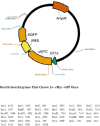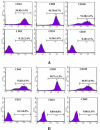Establishment of human hair follicle mesenchymal stem cells with overexpressed human hepatocyte growth factor
- PMID: 28702144
- PMCID: PMC5501929
- DOI: 10.22038/IJBMS.2017.8834
Establishment of human hair follicle mesenchymal stem cells with overexpressed human hepatocyte growth factor
Abstract
Objectives: Chronic liver disease has become a major health problem that causes serious damage to human health. Since the existing treatment effect was not ideal, we need to seek new treatment methods.
Materials and methods: We utilized the gene recombination technology to obtain the human hair mesenchymal stem cells which overexpression of human hepatocyte growth factor (hHGF). Furthermore, we verified the property of transfected cells through detecting surface marker by flow cytometry.
Results: We show here establishment of the hHGF-overexpressing lentivirus vector, and successfully transfection to human hair follicle mesenchymal stem cells. The verified experiments could demonstrate the human hair follicle mesenchymal stem cells which have been transfected still have the properties of stem cells.
Conclusion: We successfully constructed human hair follicle mesenchymal stem cells which overexpression hHGF, and maintain the same properties compared with pro-transfected cells.
Keywords: HGF; Hair follicle; Lentivirus; Liver diseases; Stem cells.
Figures




















Similar articles
-
Human hair follicle-derived mesenchymal stem cells: Isolation, expansion, and differentiation.World J Stem Cells. 2020 Jun 26;12(6):462-470. doi: 10.4252/wjsc.v12.i6.462. World J Stem Cells. 2020. PMID: 32742563 Free PMC article. Review.
-
Therapeutic role of human hepatocyte growth factor (HGF) in treating hair loss.PeerJ. 2016 Nov 1;4:e2624. doi: 10.7717/peerj.2624. eCollection 2016. PeerJ. 2016. PMID: 27833804 Free PMC article.
-
[Research of lentiviral vector mediated growth factor gene-modified bone marrow mesenchymal stem cells].Zhongguo Xiu Fu Chong Jian Wai Ke Za Zhi. 2010 Aug;24(8):972-6. Zhongguo Xiu Fu Chong Jian Wai Ke Za Zhi. 2010. PMID: 20839448 Chinese.
-
Therapeutic effects of hepatocyte growth factor-overexpressing human umbilical cord blood-derived mesenchymal stem cells on liver fibrosis in rats.Cell Biol Int. 2014 Jan;38(1):106-16. doi: 10.1002/cbin.10186. Epub 2013 Oct 17. Cell Biol Int. 2014. PMID: 24115681
-
Advances in Regenerative Stem Cell Therapy in Androgenic Alopecia and Hair Loss: Wnt pathway, Growth-Factor, and Mesenchymal Stem Cell Signaling Impact Analysis on Cell Growth and Hair Follicle Development.Cells. 2019 May 16;8(5):466. doi: 10.3390/cells8050466. Cells. 2019. PMID: 31100937 Free PMC article. Review.
Cited by
-
Adipose tissue stem cells in regenerative medicine.Ecancermedicalscience. 2018 Mar 28;12:822. doi: 10.3332/ecancer.2018.822. eCollection 2018. Ecancermedicalscience. 2018. PMID: 29662535 Free PMC article. Review.
-
Human hair follicle-derived mesenchymal stem cells: Isolation, expansion, and differentiation.World J Stem Cells. 2020 Jun 26;12(6):462-470. doi: 10.4252/wjsc.v12.i6.462. World J Stem Cells. 2020. PMID: 32742563 Free PMC article. Review.
-
Extracellular vesicles from hair follicle-derived mesenchymal stromal cells: isolation, characterization and therapeutic potential for chronic wound healing.Stem Cell Res Ther. 2022 Apr 8;13(1):147. doi: 10.1186/s13287-022-02824-0. Stem Cell Res Ther. 2022. PMID: 35395929 Free PMC article.
-
Recent advances in the therapeutic efficacy of hepatocyte growth factor gene-modified mesenchymal stem cells in multiple disease settings.J Cell Mol Med. 2022 Sep;26(18):4745-4755. doi: 10.1111/jcmm.17497. Epub 2022 Aug 3. J Cell Mol Med. 2022. PMID: 35922965 Free PMC article. Review.
References
LinkOut - more resources
Full Text Sources
